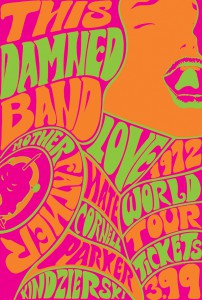
Written by Paul Cornell
Art by Tony Parker
Colors by Lovern Kindzierski
Published by Dark Horse Comics
This Damned Band #1 starts to answer this question, “What if the Satanic connection that fundamentalist Christians said rock ‘n’ roll bands had was actually true?” The comic follows a British five piece called Motherfather as they play a show in Japan, get laid backstage, say all kinds of supernatural mumbo jumbo, and keep forgetting that they’re in a documentary. Sadly, writer Paul Cornell doesn’t go beyond rock star excesses for most of the issue with the exception of Kev trying to have a wife and four kids while his bandmates have an impromptu drug filled orgy. There is also Clive, who calls himself the “creator” of Motherfather, and starts out as a posturing, mane sporting frontman a la Robert Plant, but becomes more twisted as the story progresses.
Artist Tony Parker truly commits to the documentary style for the entirety of This Damned Band #1 even towards the end of the comic in which the horror and fantasy elements really kick in. (The last few pages are the fantasy sequences in Led Zeppelin’s The Song Remains the Same meets the Lovecraftian mythos.) Parker uses a realistic style for his depictions of people and plays the concert sequences straight instead of introducing surreal elements a little too early. However, he leaves room for some exaggerated facial sequences to add some black comedy to the issue, like Motherfather’s racist, misogynistic manager Mr. Browley berating the managers of the Japanese venue. The largeness of Browley’s bodily dimensions helps sell the fact that this is a horrible human being even if the way Cornell writes leads to some nervous, dark chuckles.
One scene that Cornell thankfully doesn’t play for laughs is the backstage “wives and groupies” parts. The members of Motherfather just see these women as sex objects, and there is even a racist element with girls dressed up as geishas standing motionless in the background. Cornell and Parker don’t shy away from showing the sexist treatment of women by many of the rockers of the 1970s, but also don’t glorify their behavior by any means. Cornell even crafts a “lead groupie” named Summerflower, who mutters to herself about the annoying natures of the members of Motherfather and gives her an integral role in the magical bit of the storyline.
Parody and horror elements aside, This Damned Band #1 does feel like a by the numbers music documentary for most of the issue with its less than developed characters (Except Kev, Clive, and maybe Summerflower.) and almost checklist approach to sex, drugs, and rock ‘n’ roll. However, the comic starts to take off around the back third with Paul Cornell and Tony Parker embracing the weird, especially visually. Cornell also shows how empty the content of both Motherfather’s music and lyrics are, which might be This Damned Band‘s biggest gag. This group of bastards literally needed a deal with the devil to be any good as a band.
This Damned Band #1 is an uneven first issue, but the occasional brilliant bits of parody and a promising third act slightly redeem its more derivative aspects.

